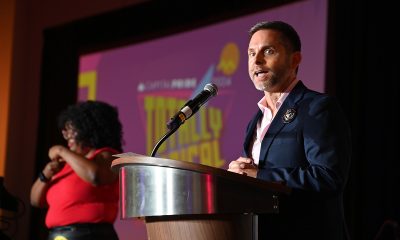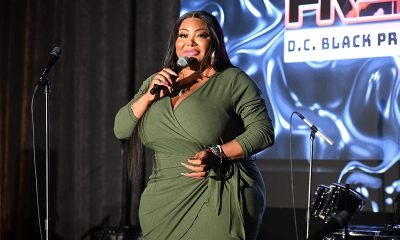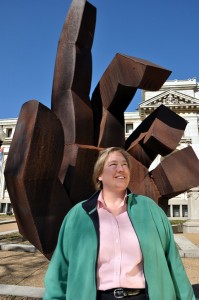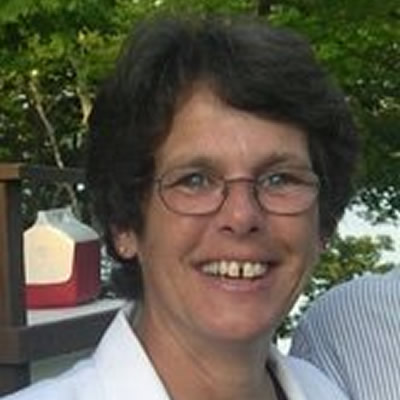Living
Queery: Jane Hoffman
The Not What You Think singer answers 20 gay questions
Jane Hoffman was snatched for fill-in duty by Not What You Think, a local LGBT a cappella singing outfit, out of necessity. She’d joined the now-defunct Lesbian and Gay Chorus of Washington shortly before. Think was a subsidiary group of the larger Chorus and needed an alto to sub for someone who couldn’t go on a San Francisco tour in 1996. She’s been in the group ever since.
“I’d just moved back to the states and was kind of new to the city and new to coming out,” the 48-year-old South Dakota native says. “I had been missing music in my life and just thought, ‘Oh gosh, you can be out and in a gay and lesbian singing group. This sounds perfect for me.'”
The all-volunteer group performs at Hillwood Museum and Gardens Sunday at 2 p.m. and at Intersections: a New American Arts Festival on March 13 at 3:30 p.m. To attend the former, an admission fee to Hillwood is required. Visit hillwoodmuseum.org for details. The Intersections show is free but reservations are required. Visit nwyt.org for information. The group’s latest release, “Never Give Up” features songs by Lennon/McCartney, James Taylor, Holly Near, Don McLean and several traditional South African songs.
Members will often trade harmony lines so that parts, especially for tenors and altos, don’t always fall along traditional gender lines, a concept reflected in their name.
“It’s very sweet and it’s really special because you really have to listen to each other to pull it off,” Hoffman says. “We don’t really take ourselves that seriously but it really is kind of a metaphor for life. And the whole idea of the group in a way is to provide gay men and women a chance to talk together and listen in a different way.”
Hoffman met her partner, Jill Strachan, in the Chorus. They’re both in Not What You Think (Strachan sings soprano) and live together on Capitol Hill.
She spent three years working as a Peace Corps volunteer in Malawi, went to grad school in New Haven, Conn., then lived three years in the early ’90s in Prague in the Czech Republic doing finance work for companies that wanted to expand to Eastern Europe.
In D.C. since 1995, Hoffman now works as a finance director for a network of public charter schools. She enjoys singing, walking her two dogs, reading and traveling. She and Strachan visited Greece last November. (Blade photo by Michael Key)
How long have you been out and who was the hardest person to tell?
I was a bit of a late bloomer and came out in the early 1990s. The hardest person to come out to was myself. My experiences in coming out to others have been positive.
Who’s your LGBT hero?
Harvey Milk and Jane Addams
What is Washington’s best nightspot, past or present?
I rarely go out to nightspots, but I always enjoy going to The Phase (Phase 1), and I am a big fan of Mr. Henry’s.
Describe your dream wedding.
I have never given this a moment’s thought. I’ve never understood the energy and resources poured into weddings. If my partner and I were to marry, it would be to gain access to specific federal benefits (currently unavailable) and I think our ceremony would be as simple as possible.
What non-gay issue are you most passionate about?
Education and women’s issues.
What historical outcome would you change?
The fact that our country was built, in large part, on slave labor.
What’s been the most memorable pop culture moment of your lifetime?
Watching Michael Jackson’s “Thriller” video on MTV in 1983. Also, the Ellen DeGeneres coming out show in 1997.
On what do you insist?
Honesty, integrity, passion and a sense of humor. I also love a good beer.
What was your last Facebook post or Tweet?
I like to share links to people or causes I think my friends will find interesting. Recent links include Andy Borowitz (he makes me smile every day) and Stand by Planned Parenthood (I am appalled at the recent attacks on this important organization). My next post will be about Not What You Think’s upcoming performances at Hillwood and Intersections.
If your life were a book, what would the title be?
“Imagine My Surprise!”
If science discovered a way to change sexual orientation, what would you do?
I’d change nothing for myself. I’m afraid we would have to be on guard, though, against those who would try to use this science to change people to fit their narrow idea of normal.
What do you believe in beyond the physical world?
That we are all connected.
What’s your advice for LGBT movement leaders?
We are a diverse community and no one has all the answers. We all have a lot to learn from each other, and we should all listen more.
What would you walk across hot coals for?
Ending violence against women in this country and around the world. And, closer to home, my partner and our wonderful dogs.
What gay stereotype annoys you most?
That all lesbians and gay men like drag.
What’s your favorite gay movie?
“Tipping the Velvet” and “Philadelphia”
What’s the most overrated social custom?
Dressing up.
What trophy or prize do you most covet?
The love of family and friends.
What do you wish you’d known at 18?
That it’s OK to simply be myself.
Why Washington?
It’s a lovely city full of interesting people. Also, the arts scene is so strong. Theater, music, visual arts and dance all contribute to D.C.’s vibrancy.
Autos
A cheeky convertible: Mercedes CLE 450
Riding the freeway of love with the top down and spirits up

“Drop the top, baby!… Drop the pedal and go!”So croons Aretha Franklin in “Freeway of Love,” her classic song about a joyride in a pink Cadillac convertible.
Those free-spirited lyrics came to mind recently each time I got behind the wheel of an equally exquisite ride: the Mercedes CLE 450.
MERCEDES CLE 450 CONVERTIBLE
$76,000
MPG: 23 city/32 highway
0 to 60 mph: 4.2 seconds
Cargo space: 9.6 cu. ft.
PROS: Dreamy design. Divine handling. Dazzling amenities.
CONS: Cramped cargo area. Kinda impractical for everyday driving.
IN A NUTSHELL: Who needs two fine open-top chariots when one fabulous convertible will do? That seems to be the thinking at Mercedes, which recently replaced two of its cabriolets—the compact C-Class and midsize E-Class—with the brand-new CLE 450.
While the wheelbase is a wee bit shorter than on the outgoing E-Class model, the CLE is longer overall than either of its two former siblings. The result: more legroom than expected, especially for anyone in the front seats. Even backseat occupants may feel comfy (OK, perhaps not Brittney Griner or Carl Nassib, but still…).
Alas, trunk space is slightly scrunched, thanks to the folding fabric roof. But that power-operated top—available in black, gray or red—can be raised and lowered with the car traveling at speeds up to 37 mph. And the triple-layer acoustic material provides excellent insulation and greatly reduces outside noise. In fact, I often had to remind myself this was the CLE convertible and not the hardtop coupe.
There’s also a wind-deflector apparatus that, when activated, elevates airflow off the windshield and reduces backflow with a rear mesh screen. For added pampering, an AIRSCARF system lives up to its name, sending warm air onto the necks of front-seat passengers. (Don’t tell my husband, but I felt like an invisible suitor was wooing me, seductively blowing kisses my way.)
Convertibles usually are not as structurally rigid as their hardtop counterparts. But here again, Mercedes works its magic: The chassis—made of aluminum and high-strength steel—is so incredibly stiff that there’s absolutely no shake and shimmy. This solid body structure also provides for a safe vehicle shell.
Under the hood, there’s a spirited 375-hp turbo engine, augmented by grippy all-wheel drive and a graceful nine-speed automatic transmission. As a crazed soccer fan, I think it’s not too much of a stretch to say the driving experience combines the speed, sass and savvy of a star athlete (think Megan Rapinoe).
Inside, there are plenty of premium styling cues, as well a glitzy dashboard with 12.3-inch digital cluster and 11.9-inch multimedia touchscreen. Yes, the CLE borrows heavily from the C-Class and E-Class. But somehow—perhaps because of the low ground clearance and multi-contour seats (which include heating, ventilation and massage functions)—this cabin feels and functions more like a true cockpit.
Along with all the driver-assistance features, there are 11 airbags (including rear head airbags), pop-up roll bars and a drowsy-driver alert monitor. In case of an impending crash, an accident-preparedness system immediately tightens seatbelts, adjusts seats and closes windows.
I could go on about all the amenities, including a 17-speaker Burmester surround-sound stereo, the 64-color ambient-lighting system and more. But why bother? This is a Mercedes, after all, so you expect such babying.
What wasn’t expected? How much I keep missing this beauty after my weeklong test drive ended. It’s not as if soft-tops are practical, like minivans and SUVs. And two-door rides—coupes or cabrios—now account for less than 4% of all new-vehicle sales.
But Aretha would have understood. Classy convertibles, like her pink Caddy and the Mercedes CLE 450, represent open-air freedom and the promise of adventure.
“So jump in, it ain’t no sin. Take a ride in my machine.”
Real Estate
Pride, patriotism, and prosperity
Real estate plays role in honoring servicemembers’ legacy

As the calendar turns to late May and early June, several powerful movements and celebrations converge in a profound and colorful tapestry of remembrance, Pride, and progress.
Memorial Day in the United States honors the sacrifices of military personnel who gave their lives in service. Simultaneously, WorldPride and Black Pride commemorate both the historical struggles and enduring strength of LGBTQ+ communities worldwide.
Though these observances may seem distinct, they share powerful commonalities — solemnity, resilience, and the pursuit of equity. When viewed through the lens of real estate and community development, their intersection reveals the critical importance of space, ownership, and inclusion.
Memorial Day is more than a barbecue, a long weekend, or the unofficial start of summer. It is a solemn remembrance of those who laid down their lives for the ideals of freedom and democracy. Many of these fallen heroes came from marginalized backgrounds, including a rainbow of LGBTQ+ Americans who served valiantly, often without recognition or equal rights at home.
LGBTQ+ service members have fought in silence for decades, only gaining the right to serve openly in recent years and then having that opportunity for some individuals snatched back simply because of who they are. Memorial Day is a chance not only to honor their service but also as a reminder of the injustices they endured.
Real estate plays a role in their legacy. For decades, returning veterans used the GI Bill to buy homes and build generational wealth; however, discriminatory practices like redlining and restrictive covenants denied Black veterans the same opportunities, contributing to the racial wealth gap that persists today. Similarly, LGBTQ+ veterans and their partners often faced housing discrimination with little legal recourse. These systemic barriers underscore how access to safe and equitable housing is part of the fight for justice.
Black Pride events emerged in response to racism within the broader LGBTQ+ movement, asserting that Black queer lives matter and deserve visibility. Held in cities across the globe, Black Pride is not just a festival — it is a political and cultural declaration. It amplifies voices at the intersection of race and sexuality, advocating for people who are disproportionately impacted by housing insecurity and gentrification.
Many urban neighborhoods that were once cultural havens for queer communities are being transformed by rising rents and redevelopment. While revitalization can bring economic opportunity, it must be done equitably, with safeguards in place to ensure that long-standing residents are not displaced. Real estate, in this context, becomes a tool for resistance and renewal.
WorldPride, a global event celebrating LGBTQ+ rights and visibility, is hosted by a different city every few years. It draws millions of participants, shines an international spotlight on LGBTQ+ issues, and highlights disparities in rights and protections worldwide. In countries where queer identities are criminalized, safe housing can be a matter of life and death.
Even in more progressive regions, LGBTQ+ individuals often face subtle yet persistent discrimination from landlords, real estate agents, and lending institutions. In the real estate industry, advocacy groups are working to increase representation, offer training, define ethical responsibilities, and advocate for inclusive policies to ensure housing is truly accessible to all.
The convergence of WorldPride with Memorial Day and Black Pride invites deeper reflection: What kind of world are we building in memory of those who came before? How can we ensure that freedom, the very principle so many fought and died for, includes the right to live openly and securely, regardless of race, gender, or sexuality?
The real estate industry has a unique role in shaping the future. From urban planning to homeownership policy, to income-based downpayment grants, it directly influences who has access to stability and opportunity.
Developers, policymakers, and community leaders must work together to address housing disparities. This includes funding affordable housing, protecting tenants from discrimination, and investing in communities that have been historically excluded. It also means respecting cultural legacies and ensuring that neighborhoods reflect the diversity of the people who live in them.
Memorial Day reminds us of the cost of freedom. International Pride events remind us that the fight for freedom is ongoing. As we honor the fallen, let us also honor the living – those who continue to fight for their right to exist, to love, and to call a place home. Whether waving a flag at a Pride parade, laying a wreath at a soldier’s grave, or signing a first-time homebuyer agreement, these moments are connected by the enduring belief that everyone deserves dignity, safety, and a place to belong.
Valerie M. Blake is a licensed Associate Broker in DC, MD & VA with RLAH @properties. Call or text her at (202) 246-8602, email her at DCHomeQuest.com, or follow her on Facebook at TheRealst8ofAffairs.
Real Estate
Tips for buying a house in Rehoboth Beach
And why it’s a great fit for the LGBTQ community

If you’ve ever dreamed of owning a charming beach house where flip-flops are considered formalwear and sunsets are your daily entertainment, Rehoboth Beach, Del., might just be your dream come true. It’s not just a beautiful coastal town—it’s also a long celebrated safe haven and vibrant hub for the LGBTQ community. Let’s dive into why Rehoboth Beach is a fabulous choice and how to make a savvy beach house purchase.
Why Rehoboth Is a Vibe (especially for the LGBTQ community)
1. A Welcoming, Inclusive Community
Rehoboth Beach has been lovingly nicknamed the “Nation’s Summer Capital,” and it’s not just because of its proximity to D.C. For decades, Rehoboth has built a reputation as a warm, inclusive, and LGBTQ-friendly destination. From gay-owned businesses to LGBTQ events and nightlife, this is a town where you can truly be yourself.
2. Packed Social Calendar
Poodle Beach, the LGBTQ beach hangout just south of the boardwalk, is always buzzing in the summer. Events like Rehoboth Beach Bear Weekend, Women’s FEST, and CAMP Rehoboth’s myriad of social and wellness events bring people together all year round. That’s right—you’ll never be bored here unless you want to be.
3. Small Town Charm Meets Big City Culture
You get art galleries, drag brunches, live theater, eclectic cuisine, and adorable boutiques—basically everything your soul craves—without the chaos and crowds of major cities. It’s quaint but never boring. Think: Key West vibes with a Delaware zip code.
Tips for Buying Your Dream Beach House
1. Know Your Budget and Think Long Term. Beachfront and near-beach properties come at a premium. Expect to pay a bit more for proximity to the sand and ocean views.
2. Choose Your Neighborhood Wisely. Do you want to be walking distance from the action on the boardwalk? Or do you prefer something more secluded in areas like North Shores or Henlopen Acres?
3. Rental Potential. If you’re not living there full time, your beach house could work overtime as a vacation rental. Rehoboth Beach has a healthy short-term rental market, especially in peak summer. Often times LGBTQ travelers actively seek inclusive, affirming places to stay.
4. Weather the Weather. Like all coastal areas, Rehoboth comes with a side of salt air and occasional storms. Invest in a good home inspection, especially for older homes, and be prepared for the maintenance that comes with beachfront living (yes, that includes sand everywhere).
5. Work With a Local Real Estate Agent. Look for an agent who knows Rehoboth inside and out and understands the unique needs of LGBTQ buyers. This isn’t just a house — it’s your happy place. You want someone who sees that and says, “Let’s find your sanctuary.”
Buying a beach house in Rehoboth Beach isn’t just about real estate — it’s about finding a space that reflects your lifestyle, values, and need for both community and calm. Whether it becomes your full-time home, your weekend escape, or your Airbnb side hustle, Rehoboth welcomes you with open arms (and maybe a mimosa).
Want personalized tips on navigating the Rehoboth Beach real estate market? Let’s chat! I’ll bring the listings if you bring the sunscreen.
Justin Noble is a Realtor with The Burns & Noble Group with Sotheby’s International Realty, licensed in D.C., Maryland, and Delaware. Reach him at [email protected] or 202-234-3344.
-

 Arts & Entertainment3 hours ago
Arts & Entertainment3 hours agoShakira cancels WorldPride concert
-

 District of Columbia2 days ago
District of Columbia2 days agoWorldPride hotel bookings hint at disappointing turnout
-

 World Pride 20252 days ago
World Pride 20252 days agoKristine W on WorldPride, drag queens, and being ‘Love Personified’
-

 Photos5 days ago
Photos5 days agoPHOTOS: Black Pride Opening Reception










